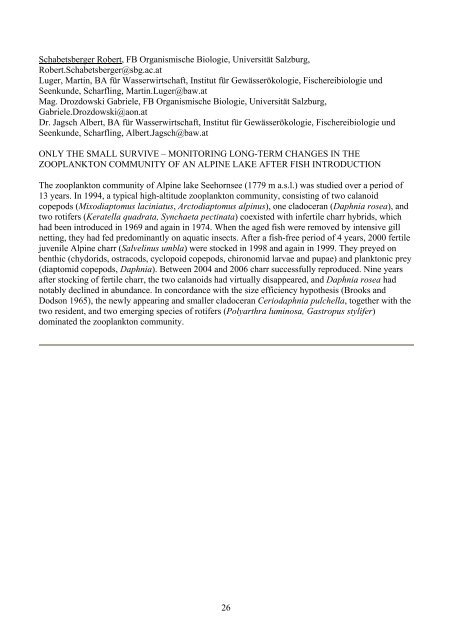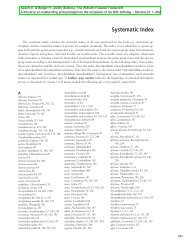abstracts der vorträge und poster - Technisches Büro für Ökologie
abstracts der vorträge und poster - Technisches Büro für Ökologie
abstracts der vorträge und poster - Technisches Büro für Ökologie
Sie wollen auch ein ePaper? Erhöhen Sie die Reichweite Ihrer Titel.
YUMPU macht aus Druck-PDFs automatisch weboptimierte ePaper, die Google liebt.
Schabetsberger Robert, FB Organismische Biologie, Universität Salzburg,<br />
Robert.Schabetsberger@sbg.ac.at<br />
Luger, Martin, BA <strong>für</strong> Wasserwirtschaft, Institut <strong>für</strong> Gewässerökologie, Fischereibiologie <strong>und</strong><br />
Seenk<strong>und</strong>e, Scharfling, Martin.Luger@baw.at<br />
Mag. Drozdowski Gabriele, FB Organismische Biologie, Universität Salzburg,<br />
Gabriele.Drozdowski@aon.at<br />
Dr. Jagsch Albert, BA <strong>für</strong> Wasserwirtschaft, Institut <strong>für</strong> Gewässerökologie, Fischereibiologie <strong>und</strong><br />
Seenk<strong>und</strong>e, Scharfling, Albert.Jagsch@baw.at<br />
ONLY THE SMALL SURVIVE – MONITORING LONG-TERM CHANGES IN THE<br />
ZOOPLANKTON COMMUNITY OF AN ALPINE LAKE AFTER FISH INTRODUCTION<br />
The zooplankton community of Alpine lake Seehornsee (1779 m a.s.l.) was studied over a period of<br />
13 years. In 1994, a typical high-altitude zooplankton community, consisting of two calanoid<br />
copepods (Mixodiaptomus laciniatus, Arctodiaptomus alpinus), one cladoceran (Daphnia rosea), and<br />
two rotifers (Keratella quadrata, Synchaeta pectinata) coexisted with infertile charr hybrids, which<br />
had been introduced in 1969 and again in 1974. When the aged fish were removed by intensive gill<br />
netting, they had fed predominantly on aquatic insects. After a fish-free period of 4 years, 2000 fertile<br />
juvenile Alpine charr (Salvelinus umbla) were stocked in 1998 and again in 1999. They preyed on<br />
benthic (chydorids, ostracods, cyclopoid copepods, chironomid larvae and pupae) and planktonic prey<br />
(diaptomid copepods, Daphnia). Between 2004 and 2006 charr successfully reproduced. Nine years<br />
after stocking of fertile charr, the two calanoids had virtually disappeared, and Daphnia rosea had<br />
notably declined in ab<strong>und</strong>ance. In concordance with the size efficiency hypothesis (Brooks and<br />
Dodson 1965), the newly appearing and smaller cladoceran Ceriodaphnia pulchella, together with the<br />
two resident, and two emerging species of rotifers (Polyarthra luminosa, Gastropus stylifer)<br />
dominated the zooplankton community.<br />
26



